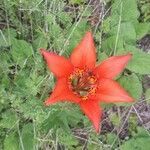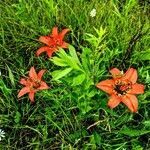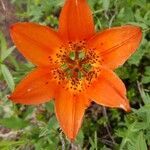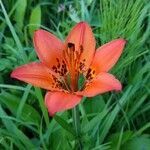Bulbs chunky, 1.6–2.9 × 2.2–4.7 cm, 0.6–1.1 times taller than long, 2(–4) years’ growth visible; scales 1–2-segmented, longest 1.2–2.2 cm; stem roots present or absent. Stems to 1.2 m, glaucous. Buds rounded in cross section. Leaves scattered, or mostly scattered with at least 1 distal whorl, or in 1–5 whorls or partial whorls, 3–11 leaves per whorl, ± horizontal and drooping at tips, or ascending in sun, 2.9–10.2 × 0.3–2.3 cm, 3.5–18 times longer than wide; blade narrowly elliptic, sometimes linear, elliptic, or oblanceolate, margins not undulate, apex acute or barely acuminate; veins and margins ± smooth abaxially. Inflorescences umbellate, 1–3(–6)-flowered. Flowers erect, not fragrant; perianth widely campanulate; sepals and petals somewhat recurved 1/4–2/5 along length from base, red-orange or red-magenta, sometimes pale orange, pure red, or rarely yellow, distinctly clawed, apex often widely acute, rarely obtuse, nectar guides above claws yellow to orange and spotted maroon, more pronounced on sepals; sepals not ridged abaxially, 4.9–8.2 × 1.6–2.6 cm; petals 4.5–7.7 × 2–3.2 cm; stamens strongly exserted; filaments ± parallel to style, barely spreading, diverging 0°–8° from axis, ± same color as sepals and petals; anthers dull maroon, 0.5–1.2 cm; pollen variously colored dark orange, brown, brown-yellow, or yellow; pistil 5–8 cm; ovary 1.3–3.2 cm; style ± same color as sepals and petals; pedicel 2.5–10.5 cm. Capsules 2.2–7.7 × 1–1.8 cm, 3–4.8 times longer than wide. Seeds not counted. 2n = 24.
More
Bulb 2–3 cm thick; stems erect, 3–8 dm; lvs 5–10 cm, acuminate, at least the uppermost in a whorl of 4–7; fls 1–5, erect; tep red-orange, varying to nearly red or nearly yellow, the blade ovate to lance-ovate, 1–2 times as long as the claw, purple-spotted toward the base, acuminate or bluntly apiculate; 2n=24. June–Aug. Two well marked vars.: Var. philadelphicum, of dry open woods and thickets from N.H. to N.C. and Ky., has the lvs mostly whorled, with or without a few alternate lvs between the whorls, lanceolate to oblanceolate, 10–15(–25) mm wide, the fr 2.5–3.5 cm. Var. andinum (Nutt.) Ker Gawl. (L. umbellatum), in meadows and along shores from O. to Minn., B.C., and N.M. has the lvs mostly alternate, except in the uppermost whorl, narrowly lanceolate to linear, 3–10 mm wide, the fr 4–7 cm.
A bulb plant. The stems are 70 cm tall. The upper leaves are in rings. The flowers are usually in groups of 1-3. They are 8 cm wide. The flower petals are orange to red. There are purple dots in the throat.
Tallgrass prairies, open woods, thickets, roadsides, powerlines, barrens, dunes, and heathlands, mountain meadows; at elevations up to 2,700 metres.
More
It is a cool temperate plant. It grows in grass prairies. It suits hardiness zones 2-6.




